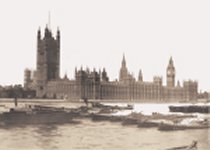|
|
Westminster by the river
Where Westminster now stands is an ancient site for habitation.
The river is shallow here and a ford existed in Roman times from the south bank
to this area, which was known as Thorney Island. A low lying and boggy area, not very inviting!
But the good transport links from the ford, which connected
directly to the main Kentish Roman road, meant that is was, like the area around
London Bridge, an area of strategic importance. Kings from as early as King Canute
have built palaces here, despite the difficulty of building in a boggy area. The
king's palace location led to the early establishment of Westminster Abbey and the
area became to centre of political and religious power.
William Etheridge, who completed the construction of the first
Westminster Bridge was a master carpenter. He worked on the bridge's construction
from 1738-1749. Firstly as James King's foreman, then replacing him after King's death in 1744.
|
NEW SCOTLAND YARD.
For a long time the headquarters of the Metropolitan Police were in an insignificant court near
Charing Cross, known as Scotland Yard, but in 1891 the present spacious premises were opened on the
Thames Embankment, near the Houses of Parliament. The lower portion of the building, hidden in our
picture by the trees, is of Portland stone, prepared - strange irony of fate! - by convicts, and the
upper portion of red brick, with stone facings. At New Scotland Yard is the office of Col. Sir Edward
Bradford, the Chief Commissioner, who wields authority over 31 superintendents, 598 inspectors, 1,831
sergeants, and 12,738 constables - 15,198 men, all told. The designs for the structure, which were the
subject of not a little hostile criticism, were furnished by Mr. Norman Shaw, R. A.
|

|
|


|
The Metropolitan Police are responsible for policing London with the exception
of the City of London and the rail network, both of which have their own police forces.
The first Metropolitan Police patrols went on to the streets on 29th September
1829, three months after the Metropolitan Police Act after much planning and
other work performed by the first joint Commissioners. The first station was set up in Whitehall after the Act of 1829
that established the police force. The name 'Scotland Yard' comes from the address of the front entrance of the
capital's first police station which was in Great Scotland Yard. The origins of that
name have been lost. This building was needed as the old premises had
been outgrown. The irony is that the building to the left of the original Scotland Yard was added only five years later to provide additional space.
The lower photograph shows the current new 'New Scotland Yard' which is located
near St James' tube station. It is currently shrouded in plastic as there are extensive
works ongoing. The Metropolitan police moved their headquarters here in 1967 having
outgrown the Shaw building.
By comparison, currently the "met" has a force of 30,265 officers.
|
|
The Embankment
The embankment along the Thames was built in the middle of the 19th Century. Its main purpose is not to contain the river, but to provide a conduit for two main public services. A by product of its construction was the reclamation of the land on which New Scotland Yard was built.
One of these is the underground railway, known today colloquially as 'the Tube'. The other vital function is to provide a route for London's sewers. These were designed and constructed under the leadership of Sir Joseph Bazalgette who was Engineer to the Metropolitan Board of Works.
|
THE VICTORIA EMBANKMENT, FROM WESTMINSTER BRIDGE.
From Westminster the river Thames shapes its seaward course with a noble bend;
and seen from the bridge, the Victoria Embankment, that engineering triumph of the late
Metropolitan Board of Works, appears at its best. Above the well-grown plane-trees lining
the Embankment rises the many-turreted block of buildings containing the National Liberal
Club. Next is noticed the arched roof of Charing Cross Railway Station, with the Bridge;
and between this and Waterloo Bridge are Adelphi Terrace, the huge Hotel Cecil, with its
flagstaffs, the Savoy Hotel, and the Medical Examination Hall; while beyond Waterloo
Bridge, our picture shows the long facade of stately Somerset House. In the foreground
is one of the floating steamboat-piers of the Thames Conservancy. One of the steamers
of the Victoria Steamboat Association has just left on its way to London Bridge, while
another boat, more crowded, is approaching, bound for Chelsea.
|
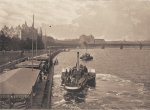
|
|

|
As you can see from this photo the floating landing stage at Westminster pier has grown in size. This is a reflection of the ever increasing popularity of river cruises.
The row of Victorian lamps along the embankment has been maintained, with the modern addition of the Air Force memorial.
Walk forward along the Embankment towards Hungerford Bridge.
|
|
Northumberland Avenue
This road runs from the Embankment at the foot of Hungerford foot and railway bridge, up to Trafalgar Square.
|
THE NATIONAL LIBERAL CLUB AND WHITEHALL COURT.
Although the National Liberal Club was established in 1882, the palatial house in Whitehall Place was not
opened until Midsummer, 1887, three years after Mr. W. E. Gladstone, the President of the Club, had laid the stone.
The architect was Mr. Alfred Waterhouse, R.A. The chief features of the "N.L.C.," which has some six
thousand members, are the " Gladstone Library," a noble room containing nearly twenty thousand volumes,
and the splendid marble spheriform staircase. There is also a terrace pleasantly overlooking one of the gardens of
the Victoria Embankment. From time to time political receptions and party meetings are held at the Club, which is
triangular in shape, the remainder of the huge block being known as Whitehall Court.
|
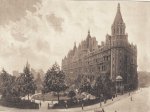
|
|
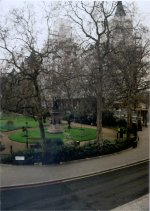
|
With the trees nearly as tall as the building and scaffolding covered in plastic it is practically impossible to see that Whitehall Court is still almost as it was in the original photograph.
|
|
|
THE HOTEL METROPOLE AND NORTHUMBERLAND AVENUE.
This view of Northumberland Avenue is taken from the Embankment, looking towards
Trafalgar Square. The tall triangular building is the Hotel Metropole, with the Whitehall
Rooms opening out upon Whitehall Place, on the left. Beyond the Metropole, in the Avenue,
is the Hotel Victoria, the eastern corner of the block being occupied by the Society for
Promoting Christian Knowledge. The not unattractive building to the right of our picture
is the Avenue Theatre, bounded by Craven Street, leading to the Strand, and by the road
heading under Charing Cross Railway Bridge. Northumberland Avenue takes its name from the
town house of the Percy family, which, having been bought by the Metropolitan Board of
Works, was removed in 1874 to make room for improvements at this spot.
|
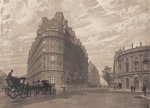
|
|

|
The theatre on the right is now called the Playhouse and is still in operation. Although it looks identical to the one above, it was designed by Blow and Billerey in 1907 after the original theatre was destroyed.
During the 1950s the BBC took over and, for the next 25 years, used the theatre as a live and pre-recorded radio studio.
The Hotel Metropole was a popular and opulent hotel until the First World War when it was requisitioned for the Ministry of Defence. It returned to being an hotel in the inter war years but has remained with e MOD since the Second World War.
|
|
Charing Cross
Charing Cross station was opened in 1864 as part of the great railway building programme of the mid nineteenth century. The Southern East Railway (later the South East and Chatham Railway) had a need to extend westward from London Bridge so as to get its passengers coming from Kent right into the heart of London.
|
INTERIOR OF CHARING CROSS STATION.
The large West End terminus of the South-Eastern Railway, though not a very
ornate structure, possesses a lofty and imposing roof. Our view is taken from the
end nearest the railway bridge, by which the old suspension bridge now at Clifton
was superseded. At this end is the Customs House, where the luggage of passengers
arriving from the Continent is examined. At the further end, facing the Strand, is
the Charing Cross Hotel, of which a view appears on plate 46. Trains leave Charing
Cross for Cannon Street every few minutes, and these largely swell the very
considerable number of trains that go in and out daily. The most interesting time
to visit the station is prior to the departure, or on the arrival, of one of the
"boat trains."
|
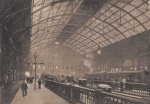
|
|
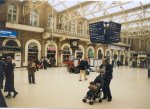
Concourse end view
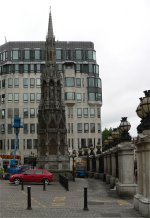
Eleanor Cross
|
The roof in the original photograph was designed by Sir John Hawkshaw. It was a single span, trussed arch with wrought iron tie rods. The roof was 164ft wide by 510ft long. It collapsed on 5 December 1905 and was rebuilt in 1907 of ridge and
furrow transverse construction.
Charing Cross station has been modenised and a large office block, constructed in 1992, now sits on top of the station. Gone is the Victorian curved roof; instead there is a low ceiling over the tracks under the new offices.There is still a vestige of the light, seen here, from the glass roof (rebuilt 1998) at the ticket office end.
Gone too is the smoke from the coal fired steam engines; replaced in this case by clean electric traction rolling stock.
Situated on the forecourt of the stations is the Eleanor Cross, and is the point from which road distances from London are measured. Queen Eleanor was the wife of Edward 1 and the cross is one of twelve erected at points on the journey where her body was rested on its way from Lincoln to Westminster for burial in 1290. This actual cross was erected in 1865.
The original Whitehall Cross was erected in 1291 near to the site of Nelson's Column and demolished by order of Parliament in 1647. This cross is a replica and is 70ft high. It was constructed by Thomas Earp of Lambeth from Portland stone, Mansfield stone and Aberdeen granite.
|
|
|
